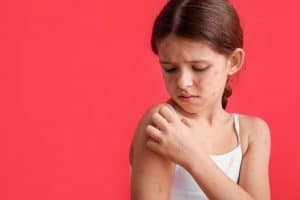Chickenpox vaccine
The disease chickenpox and chickenpox vaccine
Chickenpox is a highly contagious airborne disease caused by the varicella zoster virus. You can protect your child through vaccination and avoid discomfort, worry, longer sick leave and reduce the risk of serious complications. In many countries, chickenpox vaccine is included in childhood vaccination programs.
Spread of chickenpox
Unfortunately, it is very difficult to avoid the spread of chicken pox as a person can be infected several days before the rash breaks out. The disease is spread through the air and is highly contagious. There is a proven vaccine against chicken pox. If your child has been exposed to an infection, come to us as soon as you can. If vaccination takes place within 72 hours after the child has been exposed to infection, vaccination can help prevent chickenpox or reduce the severity of the disease.
Chickenpox vaccine
There is a proven vaccine against chicken pox. The vaccine is a live attenuated vaccine that is given from 12 months of age. The vaccine is given in two doses, either in the muscle of the upper arm of adults or in the thigh of small children, or alternatively in the subcutaneous fat, depending on which manufacturer produced the vaccine. Children are recommended three months between doses, while adults can take the doses two months apart. Chickenpox vaccine is not given to people with a weakened immune system or to pregnant women.
Vaccination against chickenpox also means a significantly reduced risk to get shingles compared to a previous chickenpox infection. Vaccination against shingles is given from the age of 50, so by vaccinating your child you reduce the risk of shingles in the time until they can get vaccinated.
The reason that vaccination is generally not recommended for adults is that approx. 98% of those who grew up in Sweden have had chickenpox.
Symptoms of chicken pox
The first symptoms of illness may be fever and body aches. Then comes the rash, which often starts on the upper body. In the beginning, the rashes are red and raised and then a blister is added, a so-called smallpox. Other symptoms are cough, stomach pain and pain when urinating caused by blisters on the body’s mucous membranes. You can also get blisters in the mouth, which can cause children to have pain when they eat.
The rashes can cause a troublesome itch and small children often tear the blisters, which means that there is a risk of bacteria infecting the smallpox in a secondary infection.
Chickenpox incubation
The time from infection to disease symptoms varies between 10 and 26 days.
Complications of chicken pox
Unfortunately, complications can arise in connection to a chicken pox infection. It’s not very common, but children can get inflammation in the cerebellum that affects their balance and ability to walk. This usually heals on its own within a few weeks, but can be uncomfortable while it lasts. Encephalitis is a rarer, but all the more serious, complication of chickenpox, and it happens that children and adults get inflammatory changes in vessels in the central nervous system that can lead to an increased risk of stroke. People with a weakened immune system are at greater risk of complications.
Chickenpox connection to Shingles
The chickenpox virus lies dormant in the nerve roots for life and can flare up as a shingles infection. You can’t get shingles from someone who has chickenpox, but a person with shingles can infect someone who hasn’t previously had chickenpox with chickenpox. There is a proven vaccine against shingles for those who are 50+.
Sources:
Folkhälsomyndigheten
CDC
Prepare visit Our clinics Book
